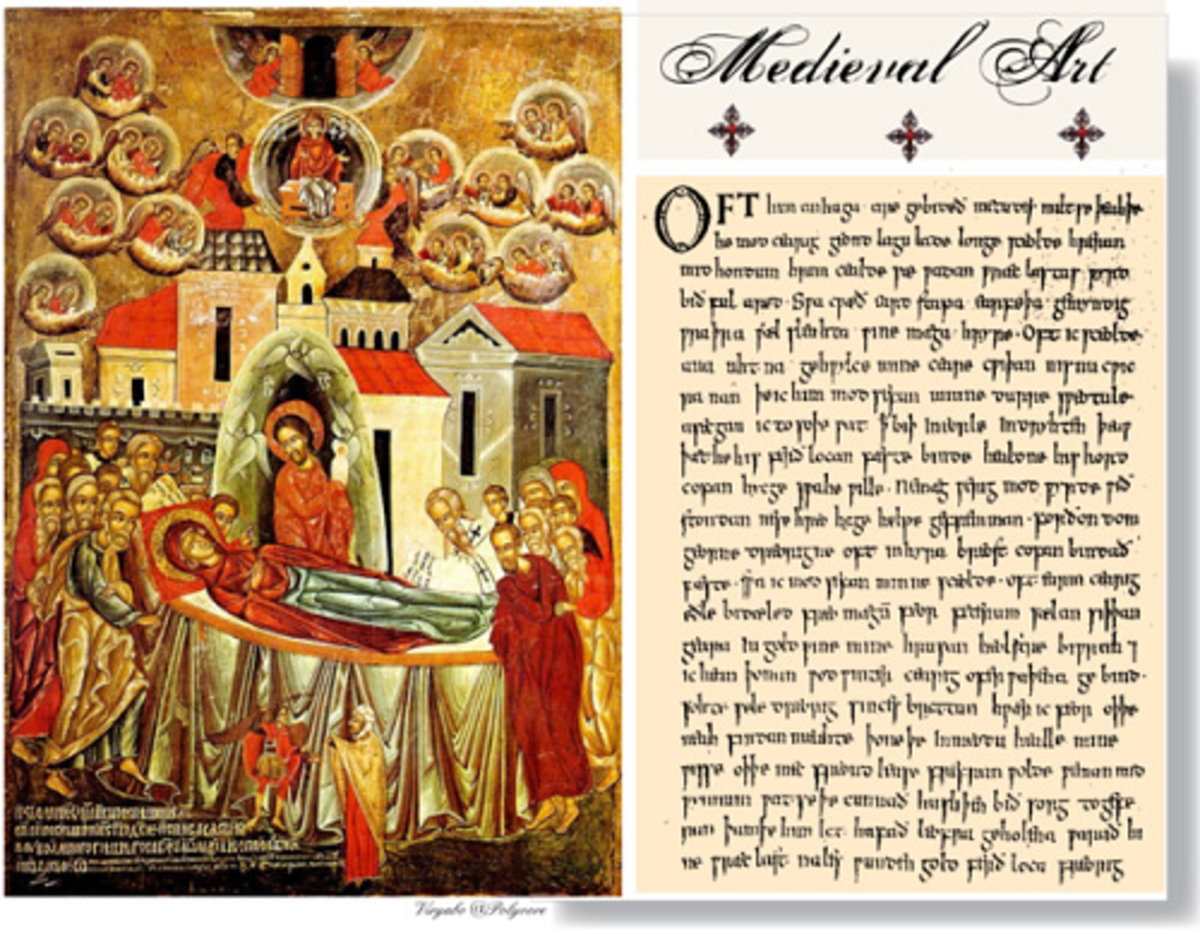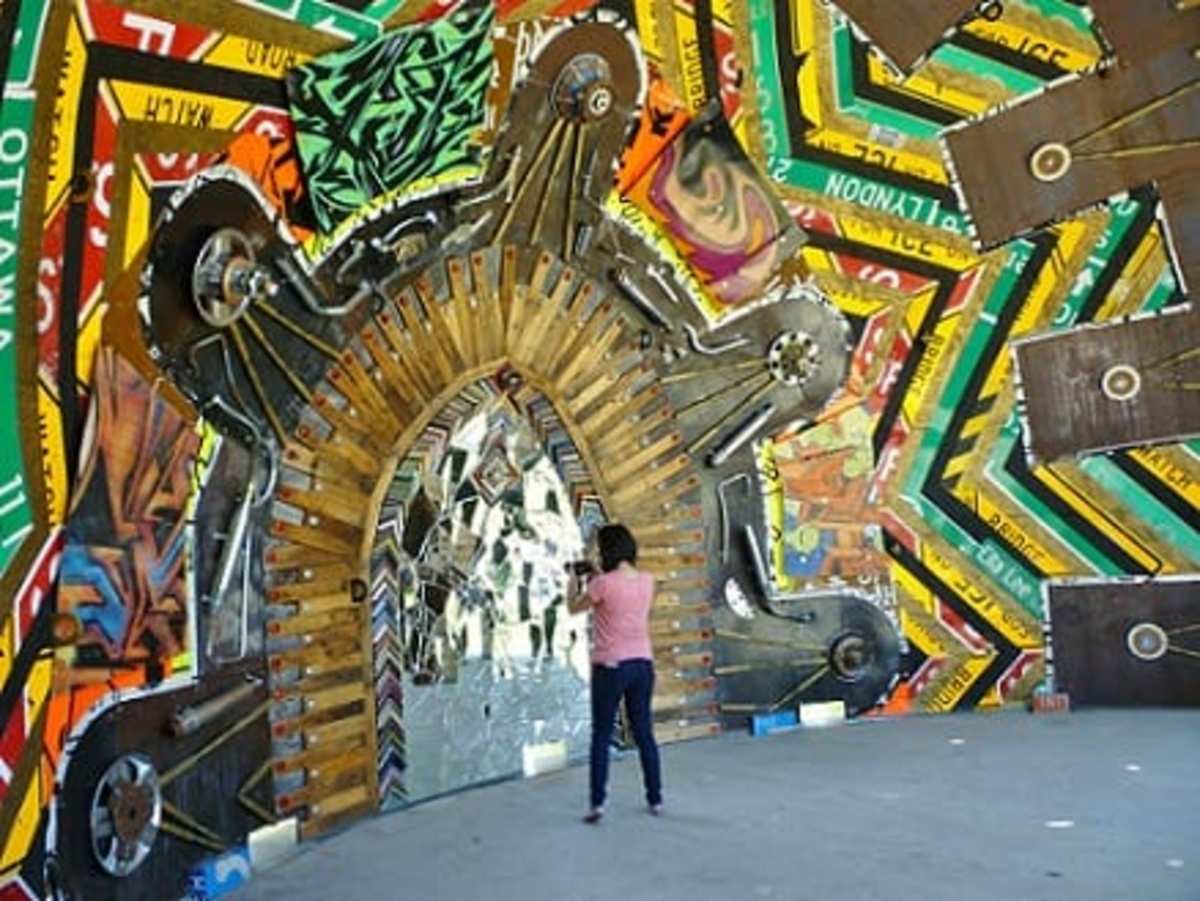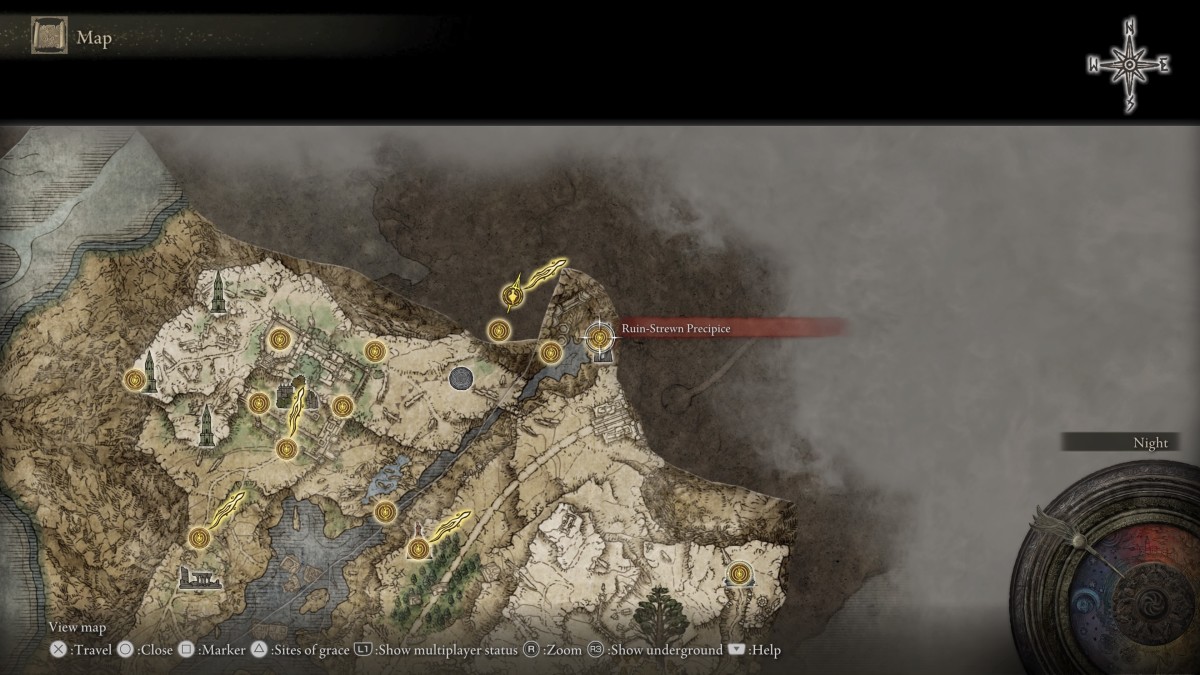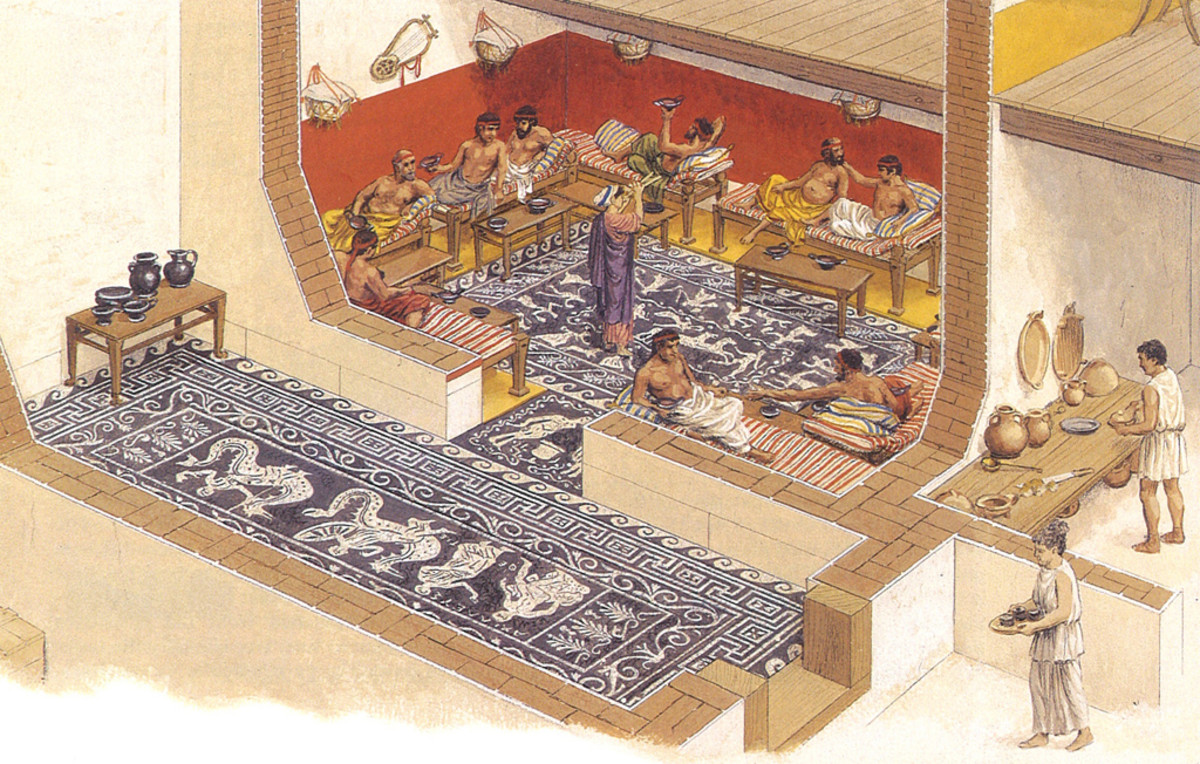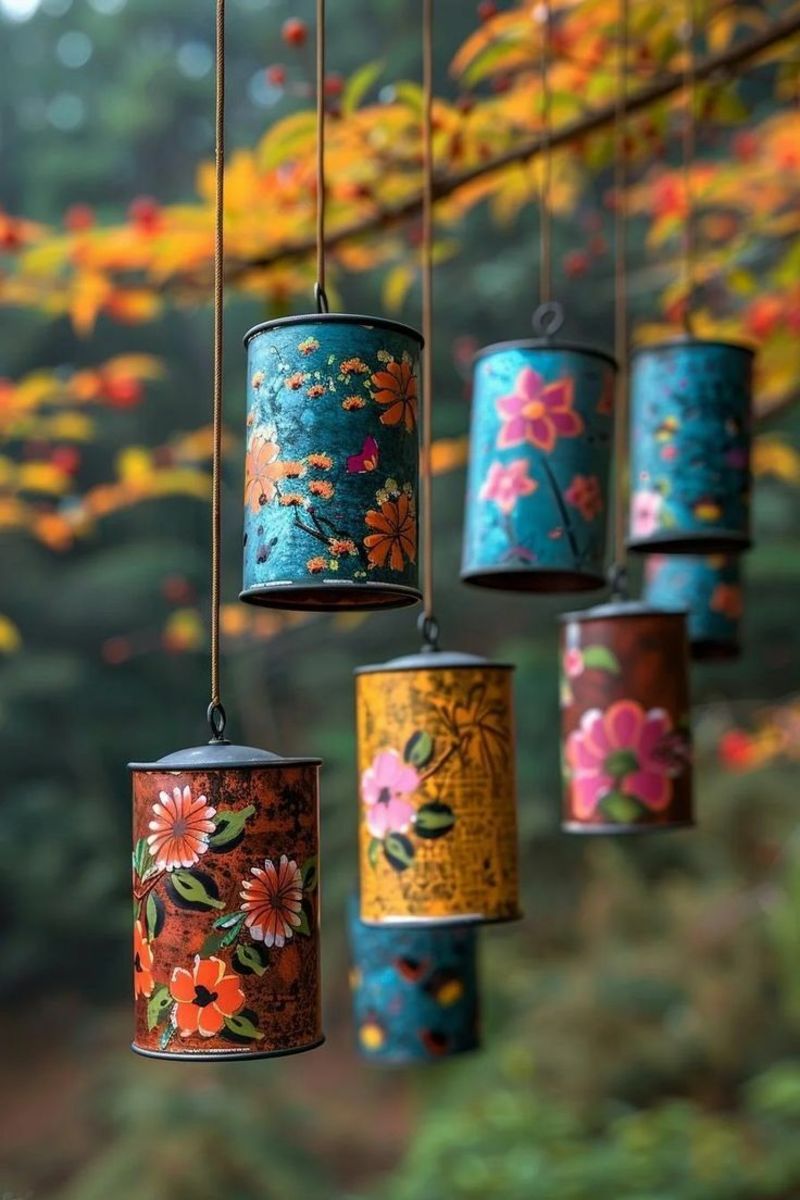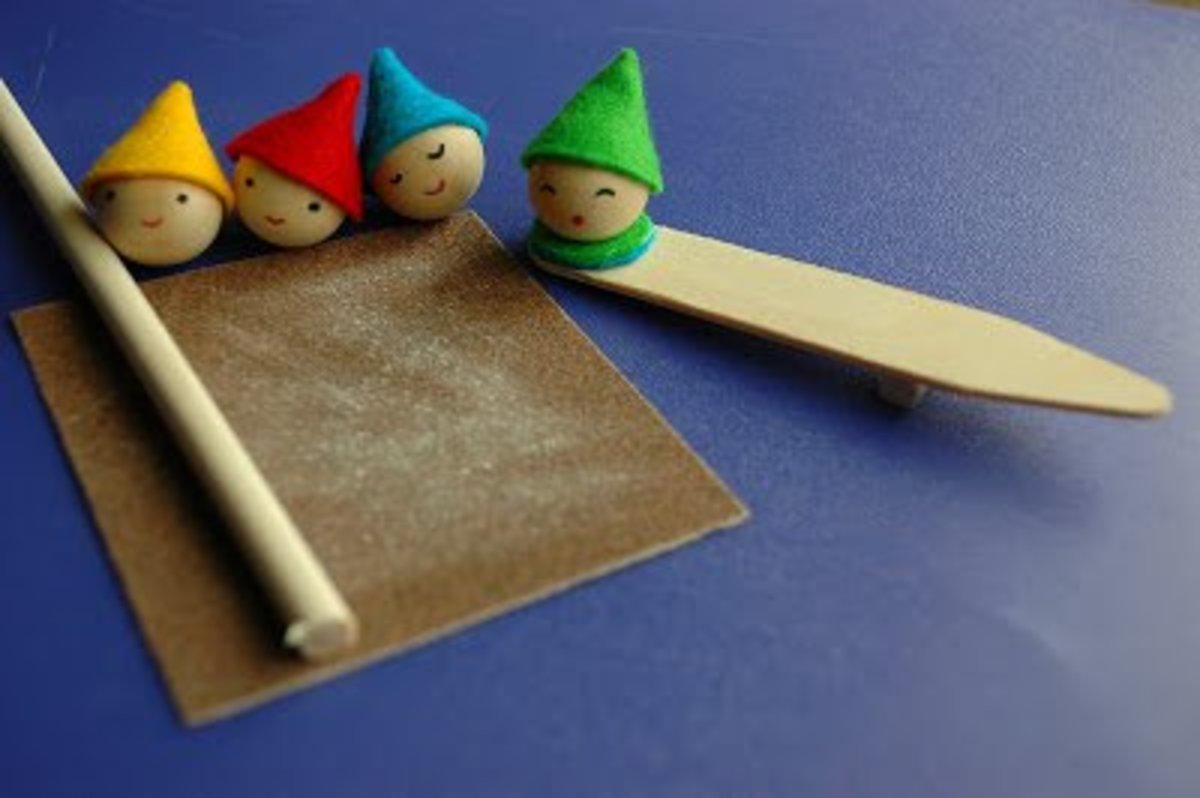Outsider Art and Houston's The Orange Show
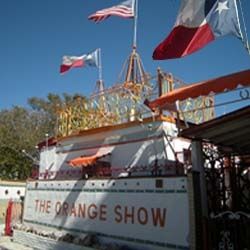
Or... Art and Architecture by Folk, Naive, and Excluded Artists
Art happens outside of the Art World.
Far from the art schools, the studios of established masters, the critics, the galleries, and the museums. Unsanctioned by authority or structured training. Usually with little or no public reward (except, often, ridicule), otherwise ordinary people feel driven to create works of art.
Outsider Art.
By definition outsider artists are self-taught, with little or no formal art training. But their work is often striking, fascinating, and sometimes visionary.
Outsider artists develop their own techniques and artistic languages - often quirky and individual, not to say eccentric. (In his day Van Gogh would have been seen as an outsider artist to a graduate of the Ecole des Beaux-Arts.)
Much of this art's charm comes from naivete of expression and the vigor and conviction - the vision - that drives the artist.
Because this is a huge topic, this Lens will mainly talk about outsider art with an architectural bent to it - that involves building or buildings, whether real or imaginary, drawn or constructed, tiny models or whole environments... First we'll talk in general, then about The Orange Show in particular.
(All photos of The Orange Show have been gifted by the copyright holder to the Public Domain for use by anyone, for any purpose, without restriction. Though a link back is always nice.)
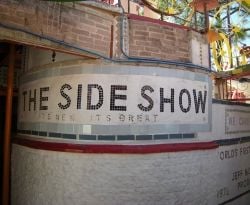
Vistor Information
Visit this Website Before You Visit
Orange Show Center for Visionary Art
"Celebrating the Artist in Everyone."
This organization is housed in Jeff McKissack's old house - a modest bungalow across the street from his The Orange Show. I just happened to visit on a day and time when The Show wasn't open... but the knowledgeable and very kind staff of the Visionary Art center opened the gate just for me.
(It would be better to check the times though!)
NOTE: The Orange Show has been closed for restoration, so be double sure to check it's reopened before making the trip! It'll be all the shinier orange when it reopens though.
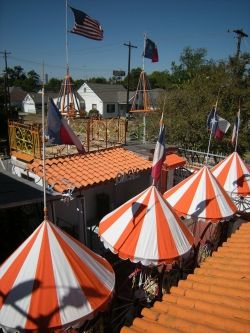
Who Are Outsider Artists?
What Makes It "Outsider" Art?
If you've been trained at the French Academe or The Art Institute of Chicago raise your hand.
You are NOT an Outsider Artist.
If you've had formal art training or simply looked at a lot of establishment art, it's hard to see outside of the norms and point of view of the art world... Artists absorb the attitudes, goals, and mindset of the art of their time, as well as using the accepted professional materials and techniques. (Author Terry Pratchett once had a character comically define Art as having an urn around someplace or a cupid or both. Like many Old Master paintings.) Fine Art may be best defined, not so much by urns, as by how seriously it is taken by critics, scholars, galleries, and collectors.
Outsider artists are outside that establishment and those traditions - though they may follow other "folk" traditions of their own. Here are some of the kinds of work that we might consider Outsider Art (categories I just - poof! - made up on this spot):
FOLK ART - art by ordinary (often highly skilled!) people who work in accord with ways, tools, and materials that their teachers and ancestors would recognize and with artistic goals respectful of and informed by that tradition. The artist may be naive or quite sophisticated.
EXCLUDED ART - art by people disqualified from the Art establishment by race, gender, religion, ethnicity, lack of training... and who therefor follow their own, different artistic agendas. Nowadays openly disqualifying people is frowned on as unPC... and yet a prestigious school or gallery still helps the ol' career - and poverty always makes it tougher.
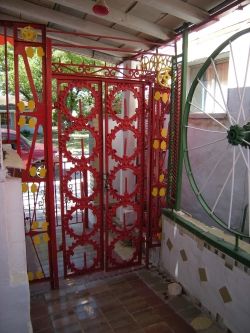
COMMERCIAL ART - 'cause it can't possibly be art if it's for money? Work done as advertising or illustrations or popular ephemera isn't really supposed to be art... but sometimes it is anyway. Time tends to make commercial art first out-of-date, then quaint, then vintage, then historic and usually a hundred years removes the odor of commerce entirely.
VULGAR ART - Comic books? Kid stuff and stuff that's just too popular to count... yet Art! Surprisingly often.
SCARCITY ART - Art made from hardship. It's made of the wrong materials or by the wrong (poor) people.
DOCUMENTARY ART - Even people without formal training want to document their lives and the community around them. If they do this well enough... Darn! Art again.
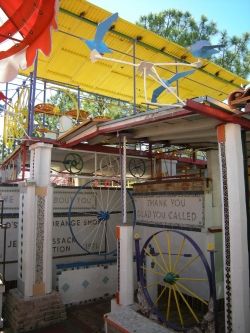
PERSUASIVE ART - Art made by people with a message. The Orange Show, for instance, was built by Jeff McKissack as an architectural billboard to his message that, "Orange juice is good for you."
All these categories blend and combine.
Outsider art can include some elements of Fine Art... and Fine Artists are forever stealing ideas from folk and outsider art. This is often how fine art gets refreshed: Duchamp's Urinal was deliberately vulgar, Warhol's Soup Can deliberately commercial, Rousseau is valued for seeming naivete, Picasso collected African tribal art and it influenced his "Les Demoiselles d'Avignon"...

Folk Art
Some outsider art is made by "folk" artists, people who work within a tradition, craft, or genre - like quilting - that has been largely ignored by the world of Fine Art. Other folk arts would include the whale bones and teeth carved and engraved by sailors (scrimshaw) or the making of wooden toys and whirlygigs (and decorated mailboxes!).
Folk painting can include naive portraiture, signs, and decorative techniques like Tole, which are usually applied to household objects and furniture or even horse-drawn wagons and gypsy (or Romany) caravans. You could argue that modern air-brush painted scenes on the tailgates of pickup trucks or sides of vans are folk art..
Folk Art was/is intended to embellish the things of everyday - pottery, furniture, household linens, etc. - or to celebrate family or social events... Just as we craft holiday gifts and decorations or color Easter eggs at home today. It is exactly these spontaneous, every-man-or-woman and home-made qualities that keep contemporary Folk Art out of museums, I suspect. Only what strikes the curator as exotic or ethnic tends to be celebrated.
Folk architecture is exactly that: the ordinary, everyday buildings that ordinary everyday people build. Most of it doesn't look too special when new... but give it a hundred years and/or an outsider's eye and it can be pretty spectacular. Think about a white-washed Greek hilltop village or one of the adobe houses painted by Ndebele tribeswomen. To the Ndebele, that gorgeously painted place is just probably just Mom's house.
House Painting as Art
Ndbele women are in charge of painting their homes and take great pride in inventing beautiful new designs and patterns and attractive color selections.
Tradition is an important resource, but elements of new technology also influence their designs: for instance, when steel razor blades were first introduced to the area, that distinctive notched/perforated razor blade shape was soon incorporated into the designs for house decorating.
This book documents and celebrates the range of design and the bold graphics of these "folk" artists.
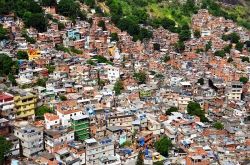
Excluded Art
Similarly, art made by any excluded or marginal group - by any one outside the high culture establishment - might be considered outsider art...
Like graffiti and street art. Or tattoos.
Those punks... artists? Street art is all the more outside because it is usually illegal. And, strangely, if a street artist like Keith Herring prospers and becomes mainstream-popular, he's accused of selling out. (Pretty much how "literary" novelists treat best-selling novelists.)
Many women's art forms have been left outside the fine art canon, for instance: lace making, embroidery, hand-weaving, basket-weaving. Of the textile arts, only tapestry making - in the Middle Ages a largely female business - has been received with due seriousness. (Strange to think the creativity of half the species for most of its history is "outsider", but there you are.) Just the fact that the work was made by a woman sometimes kept it from being taken seriously, as the early female painters and architects could testify.
The architectural version of this built-by-the-wrong-people dismissal would be the historic disregard for the buildings of any indigenous people compared to the architecture of their conquerors; or of colonial architecture compared to the motherland's; or of country building versus urban designs... or, basically, those hicks versus us city-slickers in any time or place.
Today's excluded architecture would include pretty well anything constructed in a trailer park or an encampment of poor people, although favelas and shanty towns - like around Buenos Aires, Rio, or Calcutta - can be filled with both dire misery ("villas miseria") and exuberant ad-hoc invention, form, and color.
New Public Domain about Favelas
An interesting article with great colored photos of painted Favelas.
Junk Culture article "Dionisio González: Favelas" A photo collection.
Documenting Excluded Art
A few books on various types of Outsider and especially what I'd call Excluded art and artists.



A Terrific Film About Street Art - And its complicated relationship to establishment art and commerce.
This celebrated film starts out as a pretty standard documentary about street art and artists... but somewhere along the way it turns into a biography of the documentary maker... and then, just when it starts to get a little dull... it hooks left and turns into a study of the nature of outsider art and its relationship to insider art and to commerce and...
Well, it's an entertaining trip filled with the top artists of this genre. Worthwhile if only for the footage with the elephant.
Started by the wannabe street artist/documentary filmmaker who turns into the subject (and ends up selling a LOT of art too), but finished by the renowned street artist Banksy.
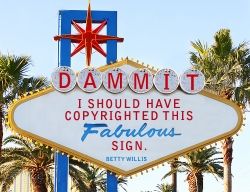
Vulgar Art
"Vulgar" as in "Common" or for the common man. You know - POPULAR.
(Fine art types can get snobbish.)
Art for the common man includes comics and pulp fiction... This sort of art tends to look a bit over-excited and brightly colored - like neon signs - because it's intended to appeal to a broad audience, looking for amusement and thrills.
Many of the artists in popular genres are, in fact, highly trained and skilled, and comic book art is highly sophisticated. But it IS (or was) looked down on because it glories in the vulgar, the violent, and the garishly colored. (All the fun stuff, in other words.) All kinds of ephemera like posters, fliers for bands, and even Bingo cards (Mexican Bingo cards are gorgeous!) can rise to the level of art.
On the architectural side, buildings that look like giant anythings - donuts or dinos, for instance - are too vulgar to be taken seriously as Architecture... but might be Art. Too commercial, tut tut. On the other hand, the artful structures of roadside attractions, mini-golf courses, and other pop culture buildings are too much fun to be ignored.
The Orange Show, with its cheerful orange awnings, is probably a bit vulgar. It once had mini dinosaurs too!
Las Vegas signs
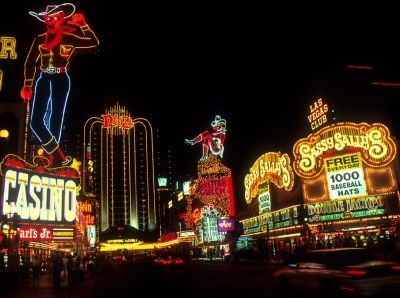
Sign Art and Neon Signs - Is Las Vegas Vulgar? Hmmm...
There is a crazy energy to many vintage and neon signs... and their presence can raise an environment from the ordinary to the spectacular, as they do in Las Vegas or in Times Square.
At the other extreme are the very low-tech signs hand painted by ordinary people... talk about "naive art"...

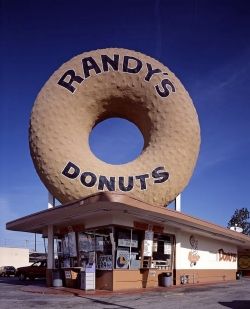
Commercial Art
I'm not sure if we can call it outsider art, but art intended as advertising is seldom hung on museum walls... yet Andy Warhol's paintings of Campbell Soup cans are. If his version is Art, then shouldn't the original commercial artist who designed that can get a gold star or something?
Many forms of creativity are somehow disqualified from Art status because their impulse comes from commerce: advertising and posters, product design, logos, TV commercials... a whole range of graphic output. But you only have to watch the fuss made about Superbowl TV ads to see that they can have cleverness, vitality, and artistic merit to spare!
The architectural end of this ad-art tends to be buildings a little too intent on selling something: restaurants shaped like donuts, for instance. Yet the Chrysler Building - respected Architecture - features Art Deco hubcaps, fenders, and other bits and pieces of Chrysler cars?
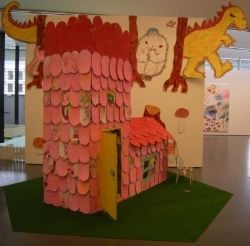
Scarcity Art
Some outsider art is made in desperation, as a way to earn cash, or for the comfort of self-expression, or simply to have something beautiful in a hard situation, like Tramp Art made during the Depression era or art made by prisoners. (I have an intricate and stiff macrame belt made from thin string that was made by a convicted murderer with lots of time on his hands.) Sometimes unlikely art is the only escape.
This sort of art is generally made from any materials at hand.
Lack of budget is common to most outsider art (the artists aren't getting many NEA grants, for instance). These artists often scrounge for materials... using thrown-away and inexpensive-because-unwanted objects, part, and pieces. So one of the joys of their art is the clever - or just bizzare - uses for unexpected materials.
The picture shows a cardboard house/sculpture by Japanese artist Ayako Rokkaku. She's a recognised artist - an "insider" - but she first used cardboard as an art material for the same reason the "outsiders" do... it was free and she was an art student without funds. (Click on the pic to go to a Lens on building toys where the picture is much bigger.)
At The Orange Show Jeff McKissack used a lot of "found" metal pieces - which add unexpected detail and texture to his railings, gates, and other metal fabrications. His tile work too, may have been made from scrap material.
The Orange Show
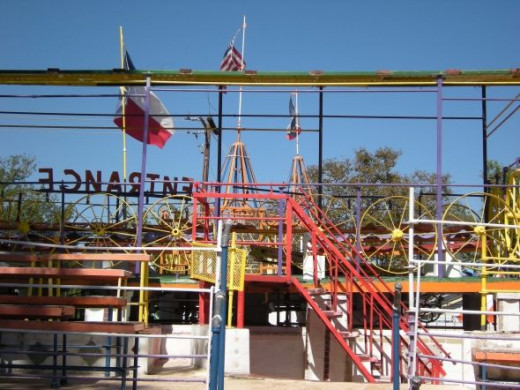
Built mostly from salvage, scrap, and "found" materials.
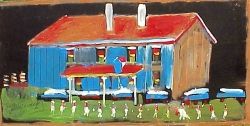
Documentary Art
Many outsider artists - like Grandma Moses - work from a desire to chronicle their lives and the community around them. Or to explain or illustrate personal beliefs or fantasy worlds.
(Click on the picture by outsider artist Jimmie Lee Sudduth, to go to VisionaryArt.com where it and other art is for sale.)
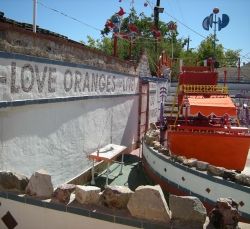
Persuasive Art
Perhaps most outsider artists want to express their strong beliefs and ideas to others. Much outsider art has a strong religious or spiritual or maybe political bent, but it almost all has a real urge to spread the word.
The Orange Show, for instance, was sparked by it's builder's evangelical desire to let the world know the importance of orange juice.
"Love Oranges and Live"
- Jeff McKissack
The Orange Show - Houston Texas
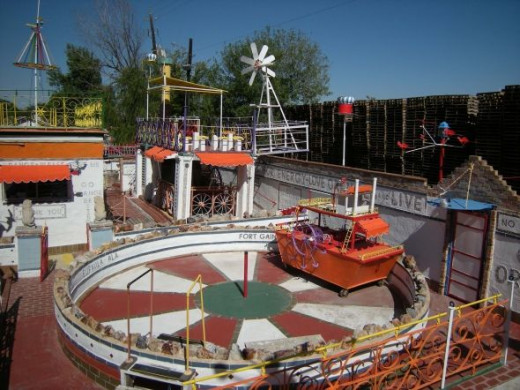
According to The Orange Show's visitors' Guide:
Jeff McKissack moved to Houston in 1952 and, two years later, he bought the vacant lot across Munger street from his house.
He started out building a plant nursery "The American Tree Nursery and Worm Ranch." Eventually those exterior masonry walls would became the start of his The Orange Show. In 1956 McKissack took out a building permit to add on a beauty salon to the site. Then, in 1964, he closed his nursery and decided not to build the salon. It was at about this time that he decided to create his life-project, a decision he credited variously to a voice pronouncing "The Orange Show," but also to an early meeting with Thomas Edison and his own long-time quest to invent the perfect orange juicer.
His interest (not to say obsession) with oranges seems to go back to the Depression, when he earned money trucking oranges and selling them at farmers' markets between Apalachicola, Florida, and Atlanta, Georgia. After that he built a plant nursery and a concrete block home in Florida, where he also had a cafe - developing skills he would use in building The Orange Show.
McKissack had a variety of careers: he earned a degree in Commerce from Mercer University, worked in a Wall Street bank, and started graduate studies at Columbia University. (It was in this northern period that he interviewed with Edison.) He also joined the Army in 1942 and was discharged after six months. After that he learned to weld and worked on Liberty ships in Florida AND earned a beautician's license. Along with learning to weld, he also built another concrete block house (probably with a nursery). His final job - by now in Houston - was as a special-delivery mailman.
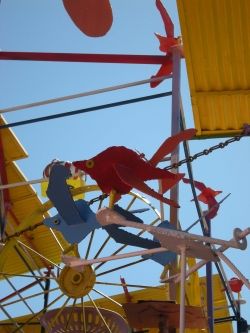
Building The Orange Show
Although the earliest construction dates from 1954, McKissack began calling his project The Orange Show in 1968. Work continued until 1979. He claimed to have spent 40,000 hours in its making.
The construction is mainly from "found" objects and scrap materials: primarily concrete block masonry with cement plaster stucco and ornamental tile details and mottos and welded steel, cast iron, and miscellaneous metal railings, gates, and decorative elements (like his charming metal birds), plus quantities of paint, and canvas awnings. There are many white walls, colorful metalwork, and quite a lot of the color orange.
The Show has a number of areas and features: The Dinosaur Exhibit (sadly, dinosaurs keep getting stolen); Chemicals By the Sea (with fruit trees, nut trees, and vegetable plants - in his lifetime real shrubs, I believe); The Body is a Complex Chemical Plant; The Map (with eccentric spelling); The Clown; The Oasis (praising vitamin C and dispensing orange juice and water); Santa's Son (once a diner's Santa); the Ladies' Restroom (larger and more elegant than the Men's); The Obelisk (once part of a Houston hotel); Gift Shop (intended to sell his perfected orange juicer... except he never perfected it); Automobile Tiles (why? he didn't drive); The Museum (all sorts of junk got covered over by plaster); The Frog and the Churn (something for the kiddies); The Bride...
Well, you get the idea.
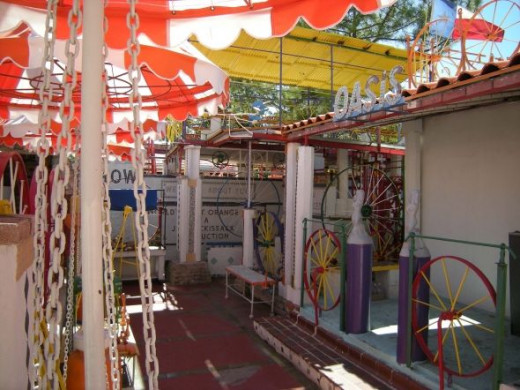
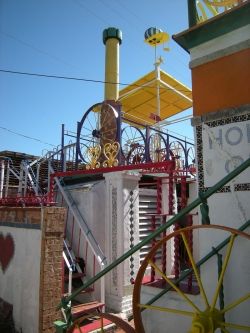
Meaning?
Every piece, every space and surface had interest for the Show's creator - and often a sort of iconography. Absolutely fascinating to wander through.
The main spaces are what he called The Pond - an arena-like performance area with a home-made river boat on his symbolic Chattahoochee River, and another stage called The Sideshow, with raised seating areas around both areas. McKissack intended there to be some sort of show(s) extolling the virtues of oranges but never quite got that far...
So...
Why did he build The Orange Show?
"The main purpose of The Orange Show is to encourage people to eat oranges, drink oranges, and to be highly amused."
- Jeff McKissack, creator
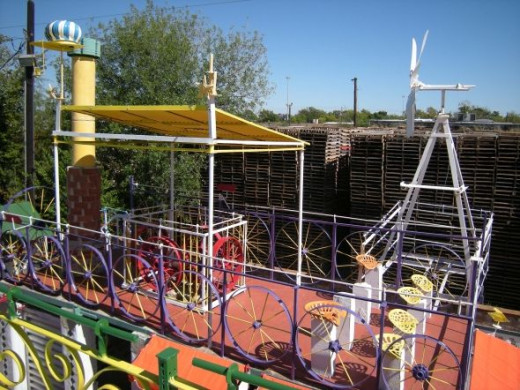
A company that sells pallets in next door - you see it at the back of the photo. But an art park is coming soon on another side of this site.
Outsider Art in Houston
Houston is an art savvy city, with some outstanding museums like The Museum of Fine Arts Houston and the world famous Menil Collection.
But it also has an especially lively outsider art scene.
Every year there is an Art Car Parade, filled with fantastical wheeled... well, your-car-as-an-art-float. (My favorite is the Sashimi Tabernacle Choir, a car covered with singing Billy Basses and Lobsters. Wonderful!) AND an Art Car Museum - well worth a visit.
There's a cool Beer Can House - an ordinary bungalow with beer can siding and sorta bead-curtain-like fringes.
And, of course THE ORANGE SHOW!.
- Smither Park, Houston
A proposed new artist-designed park near The Orange Show - The Orange Show
The master website for Houston's outsider art: The Orange Show, the Beer Can House, Art Cars and more... - Art Car Museum
The official website. - Roadside America: The Orange Show
More about The Orange Show. - Pinterest on The Orange Show
Lots of photos!
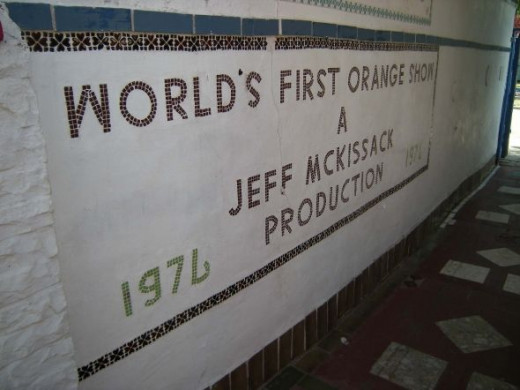
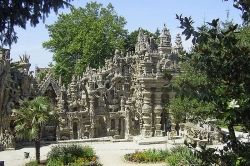
Other Famous Outsider Art Environments
Here are just a few of the outsider artists who have constructed notable architectural, sculptural, or landscape environments:
Le PALAIS IDE'AL - Hauterives, France
French postman Ferdinand Cheval (1836-1924) spent thirty-three years building his "Ideal Palace" , a stunning example of naive architecture.
In April of 1879 he tripped over a stone and was inspired by its shape. The next day he returned to the spot to start collecting stones... which started his building campaign.
As a side note: because in France it was illegal for him to be buried in his project, he later built himself a mausoleum in the same exotic pebbly European-Hindi style.
More on Chaval's masterpice here:
A short Wikipedia entry with more photos.
A blog post at Twisted Sifter on Le Palais Ide'al
Gorgeous! Wonderful photos.
FORESTIERE UNDERGROUND GARDENS- Fresno, California
Baldassare Forestiere (1879-1946) emigrated from Sicily to northern California and spent forty years hand-carving his Underground Gardens from the local hardpan soil. His work was loosely based on ancient catacombs, but he never made any drawn plan, designing as he dug... one cubic foot at a time.
Forestiere Underground Gardens
The official website for this historic landmark.
WATTS TOWERS -
Their builder Simon "Sam" Rodia (1879-1965) called his masterwork "Nuestro Pueblo." Little is known about his early life except that he worked in construction and in rock quarries.
I've visited this site - a a wild and wonderful steel and masonry fantasy, covered with stucco and broken tile (and crockery and bottles and who knows what all else?). Fantastic!
The official website for this landmark - good photos and a video.
Watts Towers doorway
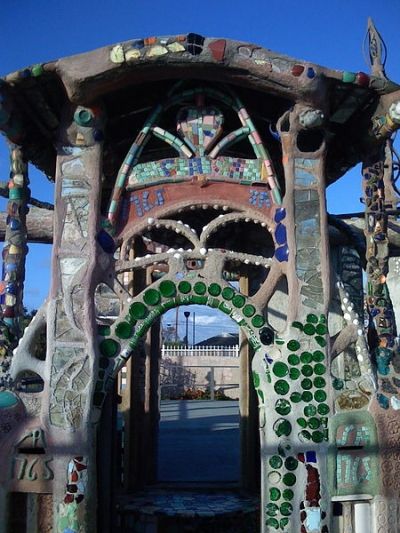
Books on Watts Towers
Worth a visit if you're in L.A. - but a book is next best thing!
Outsider Art for Outside
This book shows exactly what I'm talking about... Outdoor sculpture and building by outsider artists with a unique vision of an environment.
I haven't gotten ahold of this book yet - but I think my library needs it!
Fantasy Architecture
Architecture as biography and tribute.
Draftsman A. G. Rizzoli invented imaginary buildings to represent people in his life - his mother, the little girl next door and others - drafted these delicately in ink, rendered them with ink wash (a very unforgiving medium!), wrote accompanying essays/poems/praise of their subjects, and then put on one man shows in his mother's living room. Eccentric, obsessive, beautiful.
I saw a museum of show of Rizzoli's original drawings. They were HUGE. Incredibly detailed. And - having tried my hand at a little ink-wash rendering myself - extremely accomplished technically.
Giornale Nuovo blog post on A. G. Rizzoli
This post features images of Rizzoli's work.
Another post, at Bentolmanlikesart on A. G. Rizzoli
Even more beautiful images of Rizzoli's work.
And this is a stunning - and comprehensive - book documenting the obsessive side of mastery in the Beaux Arts classical style of architectural rendering as practiced by Rizzoli.
Books on Outsider Art
These sems to cover the spectrum of available books on the subject. But I'm keeping my eyes open!
New Duel Debate Module
Which do you prefer, Insider art or Outsider art?
How famous is famous?
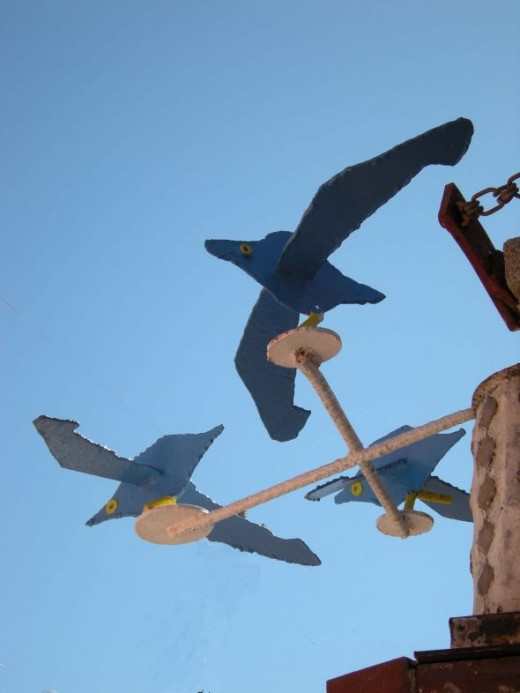
Outsider art is often little known outside of its own neighborhood. Even the famous examples.
Which of these outsider artists or sites had you heard of?
More Sites on Street and Outsider Art
- Floor Art Around the World
Hang onto the handrail as you view these fantastic examples of street art (often drawn in chalk).
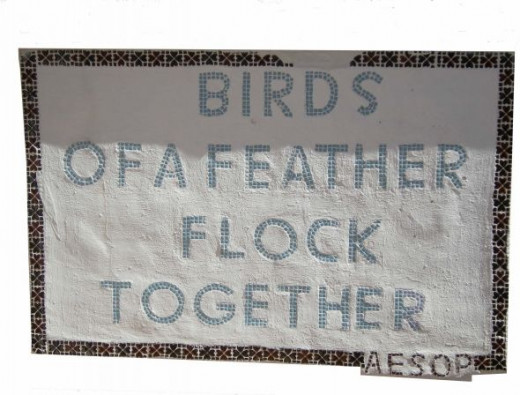
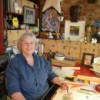

![Exit Through the Gift Shop [Blu-ray]](https://m.media-amazon.com/images/I/51eJ39nx-fL._SL160_.jpg)







